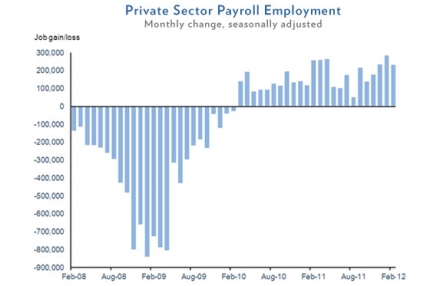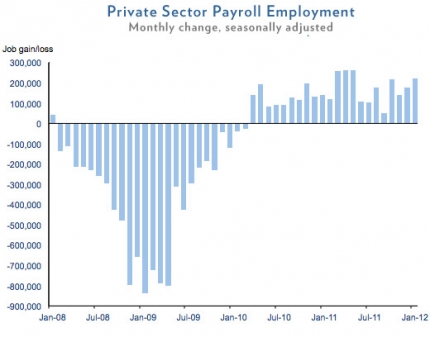Council of Economic Advisers Blog
Chairman Alan Krueger Discusses the Measurement of the Economy at the 2012 NABE Economic Policy Conference
Posted by on March 27, 2012 at 12:17 PM EDTAt 8:30 am ET on Tuesday, March 27, 2012, President Obama’s Chairman of the Council of Economic Advisers, Alan B. Krueger, delivered remarks on “Measuring the Improvement in the Economy and Improving the Measurement of the Economy” at the 2012 NABE Economic Policy Conference in Arlington, Virginia.
In his prepared remarks, Chairman Krueger said: "… the unique nature of the financial crisis and recession have made the pace of the recovery uneven, but – with the essential help of policy actions that the Obama Administration has taken – the economy is making a transition to more sustainable footing.”
Here is a link to excerpts of Chairman Kreuger’s remarks.
Learn more aboutThe Employment Situation in February
Posted by on March 9, 2012 at 10:37 AM EDTToday’s employment report provides further evidence that the economy is continuing to heal from the worst economic downturn since the Great Depression. It is critical that we continue the economic policies that are helping us dig our way out of the deep hole that was caused by the recession that began at the end of 2007, including measures to help the sectors that were most severely harmed by the bubble economy that misdirected investment and created too few durable jobs.
After losing millions of good manufacturing jobs in the years before and during the recession, the economy has added 429,000 manufacturing jobs in the past two years. For the first time since the 1990s, the manufacturing sector is adding jobs. To support a revival in manufacturing jobs and output, the President has proposed tax incentives for manufacturers, enhanced training for the workforce, and measures to create manufacturing hubs.
Private sector payrolls increased by 233,000 jobs and overall payroll employment rose by 227,000 jobs in February. The unemployment rate was unchanged at 8.3%. The unemployment rate has fallen by 0.8 percentage point over the last 6 months.
There was an increase in the size of the labor force last month of 476,000. Importantly, the increase in the labor force last month was due in large part to a reduction in the number of workers who exited the labor force between January and February.
Despite adverse shocks that have created headwinds for economic growth, the economy has added private sector jobs for 24 straight months, for a total of more than 3.9 million payroll jobs over that period. In the last 12 months, 2.2 million private sector jobs were added on net. In the last 6 months, 1.3 million private sector jobs were added, the most of any 6 month period in nearly 6 years.
Sectors with net job increases included health care and social assistance (+61,100), temporary help services (+45,200), leisure and hospitality (+44,000), and manufacturing (+31,000). Construction lost 13,000 jobs, reflecting a loss of 15,400 specialty trade contractor jobs. Employment in the Federal government fell by 7,000 jobs.
The monthly employment and unemployment numbers can be volatile, and employment estimates can be subject to substantial revision. Therefore, as the Administration always stresses, it is important not to read too much into any one monthly report; nevertheless, the trend in job market indicators over recent months is an encouraging sign.
Learn more about EconomyA Preview of the 2012 Economic Report of the President
Posted by on February 17, 2012 at 5:00 PM EDTThe Economic Report of the President has been prepared annually by the Council of Economic Advisers since 1947. The theme of this year’s Economic Report of the President is “To Recover, Rebalance, and Rebuild.” In 2011, the Nation continued to recover from the Great Recession and to make progress toward building a stronger foundation for more balanced and sustainable economic growth in the future.
The problems that caused the deep recession that began at the end of 2007 and lasted until mid-2009 were a long time in the making, and will not be solved overnight. But economic progress is being made. In 2011 the Nation continued to recover, rebalance and rebuild a stronger, more secure future. The economy has expanded for 10 straight quarters. As a result, by the third quarter of 2011, the real gross domestic product (GDP) of the United States had surpassed its peak level at the start of the 2007–09 recession.
When President Obama took office on January 20, 2009, the U.S. economy was contracting at an alarming rate, and employment was falling by more than 700,000 jobs a month. The plunge in economic activity was even deeper than the Bureau of Economic Analysis initially reported: revised estimates show that the economy contracted at an 8.9 percent annualized rate in the last quarter of 2008, from the initial advanced estimate of 3.8 percent. This was the largest quarterly downward revision ever reported.
Learn more about EconomyAn America Built to Last: Strengthening Economic Security in Retirement
Posted by on February 15, 2012 at 6:42 PM EDTIn his State of the Union message last week, President Obama laid out a blueprint for an America that’s built to last—where hard work pays off and responsibility is rewarded. Today, the Departments of Treasury and Labor are taking steps to strengthen economic security for our nation’s seniors by giving Americans greater investment information and access to more choices to plan for a secure retirement. These steps will be of particular importance to women, who tend to live longer and have fewer retirement assets and lower retirement income than men.
The Department of Labor is taking action to require 401(k) plan providers to better disclose the cost and nature of the services they provide, while Treasury and the IRS are announcing steps that will ease regulatory barriers in the market for annuities and other forms of lifetime income. The Council of Economic Advisers (CEA) has prepared a detailed report describing the significance of today’s actions, which can be accessed here.
Today’s announcements complement previous Administration initiatives to make retirement more secure for American families. In September 2009, President Obama announced expanded opportunities for automatic enrollment in retirement savings plans. The President has also championed an automatic IRA legislative proposal through which tens of millions of workers without access to a workplace retirement plan would be automatically enrolled in IRAs through payroll deposit contributions, while remaining free to opt out. And the Administration has proposed easing requirements on the timing and amount of distributions from retirement accounts for many retirees, reducing the compliance burden and providing elderly Americans with greater control over their retirement assets.
Learn more about EconomyThe Employment Situation in January
Posted by on February 3, 2012 at 10:31 AM EDTToday’s employment report provides further evidence that the economy is continuing to heal from the worst economic downturn since the Great Depression. It is critical that we continue the economic policies that are helping us to dig our way out of the deep hole that was caused by the recession that began at the end of 2007. Most importantly, we need to extend the payroll tax cut and continue to provide emergency unemployment benefits through the end of this year, and take the additional steps that President Obama proposed in his State of the Union address to create an economy built to last.
The unemployment rate fell 0.2 percentage point to 8.3%, from a high of 10% in October 2009. The drop in unemployment over the month was entirely due to employment growth, as the labor force participation rate remained constant, once new population weights are taken into account. The unemployment rate has fallen by 0.8 percentage point in the last 12 months. Private sector payrolls increased by 257,000 jobs and overall payroll employment rose by 243,000 jobs in January. Despite adverse shocks that have created headwinds for economic growth, the economy has added private sector jobs for 23 straight months, for a total of 3.7 million payroll jobs over that period. In the last 12 months, 2.2 million private sector jobs were added on net. Nonetheless, we need faster growth to put more Americans back to work.
Sectors with net job increases in December included professional and business services (+70,000), manufacturing (+50,000), leisure and hospitality (+44,000), health care and social assistance (+29,700), and construction (+21,000). Government lost 14,000 jobs.
The monthly employment and unemployment numbers can be volatile, and employment estimates can be subject to substantial revision. Therefore, as the Administration always stresses, it is important not to read too much into any one monthly report; nevertheless, the trend in job market indicators over recent months is an encouraging sign.
Learn more about EconomyAdvance Estimate of GDP for the Fourth Quarter of 2011
Posted by on January 27, 2012 at 10:45 AM EDTToday’s report shows that the economy posted its tenth straight quarter of positive growth, as real GDP (the total amount of goods and services produced in the country) grew at a 2.8 percent annual rate in the fourth quarter of last year. For 2011 as a whole, GDP rose by 1.7 percent, raising the level of real GDP 0.7 percent above where it was at the start of the recession in the fourth quarter of 2007. While the continued expansion is encouraging, faster growth is needed to replace the jobs lost in the recent downturn and to reduce long-term unemployment.
Positive contributions to real GDP growth in the fourth quarter included consumer spending (1.5 percentage points) and fixed investment (0.4 percentage point). Overall government purchases fell (4.6 percent), with substantial declines in Federal defense spending (12.5 percent) and State and local spending (2.6 percent).
Learn more about Economy
- &lsaquo previous
- …
- 16
- 17
- 18
- 19
- 20
- 21
- 22
- 23
- 24
- …
- next &rsaquo
White House Blogs
- The White House Blog
- Middle Class Task Force
- Council of Economic Advisers
- Council on Environmental Quality
- Council on Women and Girls
- Office of Intergovernmental Affairs
- Office of Management and Budget
- Office of Public Engagement
- Office of Science & Tech Policy
- Office of Urban Affairs
- Open Government
- Faith and Neighborhood Partnerships
- Social Innovation and Civic Participation
- US Trade Representative
- Office National Drug Control Policy
categories
- AIDS Policy
- Alaska
- Blueprint for an America Built to Last
- Budget
- Civil Rights
- Defense
- Disabilities
- Economy
- Education
- Energy and Environment
- Equal Pay
- Ethics
- Faith Based
- Fiscal Responsibility
- Foreign Policy
- Grab Bag
- Health Care
- Homeland Security
- Immigration
- Innovation Fellows
- Inside the White House
- Middle Class Security
- Open Government
- Poverty
- Rural
- Seniors and Social Security
- Service
- Social Innovation
- State of the Union
- Taxes
- Technology
- Urban Policy
- Veterans
- Violence Prevention
- White House Internships
- Women
- Working Families
- Additional Issues



